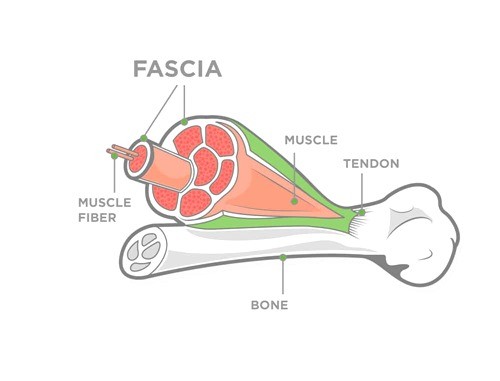With introducing Yoga Tune Up® Therapy, I don’t have a choice but to talk about fascia because where ever the therapy balls will roll, they will affect it, and it’s kind of the point. They will affect its shape, its elasticity, and its role of connection and protection! And on top, if that, it is fascia-nating!

So what is fascia?
Fascia is part of one of the body’s 3 connective tissues: hard (bones and cartilage), soft (fascia, tendons, and ligaments), and fluid (blood). It comes from Latin and means “band”. This band of connective tissue is primarily made of collagen and lies beneath the skin. It attaches, stabilizes, encloses, and separates muscles, muscle fibers, and other internal organs from each other. It’s classified by layer as superficial fascia or deep fascia, and by an anatomical position as visceral or parietal fascia.
Are you an anatomy-geek? Want to see it in real life? Watch the video below ↓. It’s super interesting and hilarious. What he refers to as Fuzz is Fascia.
!!!Warning!!! This video contains images of cadavers.
Here are a few fascia-nating facts about fascia :
- It is a single continuous and highly networked structure that exists from head to toe, without interruption.
- Made from collagen, elastin fibers, cells, and fluids, it contains most of the water of your body.
- When fascial tissue is dehydrated it becomes more sticky and stiff; the layers of fascia literally adhere to each other like Velcro.
- Velcro-y fascia will restrict the functions aka the movement of the muscles.
- When the fascia is not fluid, toxicity builds up in the muscles.
- The fluidity of fascia also responds to stress and mood. It can change shape with repetitive movement (good and bad!).
Why roll to release, massage, and hydrate the fascia?
- It allows the muscles to move more efficiently, augmenting its capacity to contract and release.
- Increases range of motion.
- Re-trains the muscles to fire properly and perform better.
- Reduces pain and recovery time after an injury.
- Releases stress.
- Helps eliminate toxins.
- Create a clearer pathway for nerve signals to flow to the brain.
- Helps augment body awareness (proprioception), coordination, and control.
Do you see now the importance of self-massage and how the Yoga Tune Up® balls can make a huge difference in your life?! Is there anything on this list you don’t want? In what part of the body do you think self-massage would be the most important for you?
Do you want to experience it in real life? Come try it during my workshop this weekend!

+ show Comments
- Hide Comments
add a comment